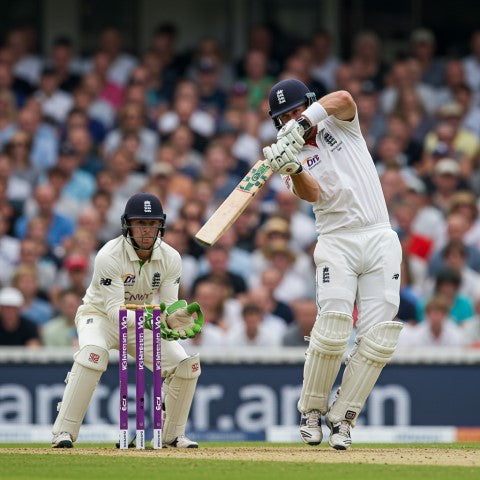Galle International Stadium: Cricket on the Edge of the Ocean

Few cricket grounds in the world offer the kind of poetry that Galle does. With the Indian Ocean shimmering on one side and the 16th-century Galle Fort rising stoically on the other, Galle International Stadium feels less like a venue and more like a postcard. A match here doesn’t just entertain; it enchants.
Tucked into the southern tip of Sri Lanka, the stadium offers a view like no other — where the salty air carries the scent of the sea and every delivery is bowled in the shadow of colonial walls. Yet beneath this beauty lies a ground steeped in both triumph and trauma. It has hosted world records and witnessed natural disasters. It has been destroyed, rebuilt, and reclaimed by the game.
For players, it’s a cauldron. For fans, it’s a sanctuary. And for cricket, it’s one of the last bastions of romanticism in an increasingly commercial sport. This article explores what makes Galle International Stadium not just unique, but essential — to Sri Lankan cricket, and to the sport’s global soul.
1. A Ground Like No Other: The Setting of Galle International Stadium
Cricket grounds are often described by their atmosphere, their size, or their pitch. But Galle International Stadium is most famously defined by its setting. Perched on the edge of the Indian Ocean, this is a ground where the line between nature and sport is beautifully blurred.
From the press box and the player dressing rooms, the view is cinematic — waves crashing in the distance, palm trees swaying beyond the boundary, and seagulls wheeling lazily overhead. It’s hard not to be distracted. Even the most hardened professionals admit to gazing out at sea between overs.
And then there’s the fort. Looming above the ground like a sentinel, the UNESCO World Heritage-listed Galle Fort gives the stadium a timeless quality. It’s not uncommon to see fans perched atop its ramparts, watching the game for free and adding to the patchwork crowd that spills across grass banks and temporary stands.
But don’t mistake the serenity for softness. The sun bakes the pitch, humidity wears down bowlers, and the turning surface can quickly become a nightmare for visiting teams. That blend — natural beauty and ruthless conditions — is what gives Galle International Stadium its unforgettable character.
2. From Fortress to Field: The History Behind the Backdrop
Before it became one of world cricket’s most picturesque venues, Galle International Stadium was little more than a racecourse. In the colonial era, British administrators used the land for horse racing and sporting events — long before a bat struck ball there in anger.
It wasn’t until 1998 that Galle hosted its first official Test match, with Sri Lanka taking on New Zealand. The debut wasn’t just symbolic — it marked the start of a new cricketing chapter for the southern province, bringing elite international sport to a part of the country long celebrated for its beauty but overlooked for its facilities.
Yet the stadium has always worn its layers of history proudly. Just metres away stands the Dutch-built Galle Fort, whose walls have seen empires rise and fall. That proximity infuses the ground with gravitas. When cricketers take the field here, they do so not in isolation but in conversation with centuries of local and colonial history.
Over time, the stadium became a stronghold for Sri Lanka’s best — particularly spinners — and a proving ground for visiting teams. Its intimate setting, historical resonance and parochial crowd created a unique pressure. At Galle International Stadium, you don’t just play cricket — you enter a narrative.
3. Tsunami and Resurrection: Galle’s Story of Survival
On 26 December 2004, the Indian Ocean tsunami struck with devastating force. Among the thousands of lives lost and towns shattered was Galle International Stadium, which was all but washed away. The images that emerged in the aftermath — the outfield submerged, seating destroyed, palm trees flattened — shocked the cricketing world.
But what followed was nothing short of remarkable. The stadium became a symbol of national resilience. With international aid, local determination, and help from the Sri Lankan cricket board, Galle slowly began to rebuild — not just as a ground, but as a source of pride for a traumatised region.
When Test cricket returned to Galle in 2007, it was emotional. The rebuilt stadium was not just structurally stronger but spiritually transformed. Fans returned in droves, many of them having lost homes, family, or friends in the disaster. Cricket, for once, was more than a sport. It was part of the healing.
That resilience is stitched into the DNA of the venue. Every boundary, every wicket, every cheer from the crowd carries a sense of gratitude. It’s why, even today, Galle International Stadium holds a deeper emotional resonance than almost any other cricket ground in the world.
4. The Spinner’s Paradise: Why Galle Rewards Guile
If you’re a spinner, this is heaven. If you’re a visiting batsman, it might be hell. From Murali to Herath, Galle International Stadium has long been known as Sri Lanka’s spinning fortress — where turn, bounce and drift create conditions that frustrate and baffle even the best.
The pitch at Galle starts out docile but can break up as early as Day 2. Cracks open. Footmarks expand. Balls spit, slide, and zip past the edge. It’s the kind of surface that turns good spinners into match-winners — and exposes any weakness in a team’s technique or temperament.
Muttiah Muralitharan, Sri Lanka’s greatest ever, took 111 of his 800 Test wickets here. Herath followed, weaving magic with left-arm spin. And in recent years, the mantle has passed to younger bowlers like Lasith Embuldeniya, who relish the challenge of bowling where expectations are high but the rewards are rich.
Captains face hard calls here. Bat or bowl first? Pack in extra spinners or trust the new ball? The pitch seduces and punishes in equal measure. And the fans, savvy and vocal, know how to get behind a home side looking to choke opponents with guile and control.
In an age where flat pitches and run-fests dominate, Galle International Stadium stands proudly apart — offering the kind of old-school cricketing theatre that’s fast becoming rare.
5. Moments That Defined It: Jayasuriya, Herath, and Test Glory
While many cricket grounds are defined by marquee events, Galle International Stadium is remembered for performances that felt deeply personal — feats born of grit, guile and homegrown brilliance.
Sanath Jayasuriya’s explosive 253 against Pakistan in 2004 still echoes along the fort’s ramparts. A son of Matara, just down the road from Galle, Jayasuriya’s knock felt like a gift to his people — a celebration of Sri Lankan audacity and flair. It wasn’t just a scorecard entry; it was a regional triumph, thunderous and defiant.
Equally iconic was Rangana Herath’s 9 for 127 against Pakistan in 2014. By then, Herath was in his late thirties — a bespectacled, understated left-armer. But at Galle, he was a titan. He spun, flighted and tormented, dragging Sri Lanka to a famous win. That spell confirmed the ground’s reputation as a spinner’s playground — but also Herath’s place in the pantheon of match-winners.
Even for visiting players, the ground has offered stages for legend. Virat Kohli’s gritty hundred, James Anderson’s furious opening spells, Steve Smith’s defiant resistance — all felt amplified by the intimacy of the venue. At Galle International Stadium, every run and wicket carries weight.
It’s a ground where moments aren’t just played. They’re etched.
6. Intimate and Intense: What It’s Like to Watch Cricket at Galle
For fans, few cricket experiences rival a day out at Galle International Stadium. It’s not just the cricket — it’s the closeness, the culture, and the sound of waves crashing while spin grips the afternoon.
Unlike sprawling mega-stadiums, Galle feels almost personal. The stands are close to the field. The grass banks invite barefoot lounging. The fort ramparts become natural viewing galleries, with tourists and locals alike peering over stone battlements to follow every over.
There’s no overwhelming digital noise or synthetic fanfare. Instead, you hear the sharp claps of fielders, the murmurs from the crowd, and the distant hum of motorbikes weaving through Galle’s cobbled lanes. Vendors walk the perimeter selling king coconuts and chilli-dusted mango slices. Spectators slip in and out, often just after their morning temple visit or between classes at the local university.
Watching cricket here is less of a ticketed event and more of a ritual. It’s relaxed but electric. Humid but unforgettable. The views change with the light — morning sun glinting off the fort, golden-hour glow on the Indian Ocean, and twilight shadows deepening as the fielders gather for one last push.
At Galle International Stadium, you don’t just spectate — you soak it in.
7. Cricket and Culture: Galle as a Tourist and Sporting Destination
A visit to Galle International Stadium is as much about the journey as the game. Situated within walking distance of the old town’s Dutch-era architecture, temples, and coastal cafés, it offers a fusion of cricket and culture few grounds in the world can rival.
Before the toss, you can wander through cobbled streets and spice markets. At lunch, you can duck out to a seafood stall or stop by a colonial-era bookstore. After stumps, there’s time for a tuk-tuk ride to Unawatuna beach or a cinnamon-infused cocktail on the fort’s ramparts.
The town of Galle has fully embraced its role as both sporting hub and heritage destination. Boutique hotels cater to cricket tourists. Cafés air highlights of Jayasuriya’s double ton. Locals share stories of tsunami survival and cricket’s role in the town’s rebirth.
For international fans, watching a match here is often part of a larger experience — Sri Lanka’s coastlines, wildlife sanctuaries, and Buddhist temples all within easy reach. And yet, Galle remains proudly small-scale. There’s no rush to turn it into a hyper-commercial venue. It remains a ground with soul.
That soul is why, year after year, cricket lovers make pilgrimages to Galle International Stadium — drawn not just by the scoreline, but by the setting.
8. Why Galle International Stadium is a Global Cricket Treasure
In a world where cricket is increasingly played in carbon-copy stadiums with booming DJs and corporate hospitality boxes, Galle International Stadium remains a defiant outlier — romantic, rooted, real.
It is one of the few venues where nature, history, and sport truly merge. Where a forward defence is met not by artificial applause, but by seagulls and sea breeze. Where legends are made, and every match feels like an event woven into the fabric of a town still marked by survival and celebration.
The ground isn’t perfect — rain delays, limited infrastructure, and tight seating persist. But perhaps perfection is not the point. Galle doesn’t try to be a global template. It is entirely, stubbornly itself. That is its strength.
For players, it is a test of skill and spirit. For fans, it is a postcard come alive. And for cricket, it is a rare gem — one of those sacred venues that reminds the sport why it matters.
Galle International Stadium is not just a ground. It is cricket — distilled, distilled into waves, stone, spin, and soul.
Conclusion: Galle International Stadium and the Poetry of Place
What gives a stadium meaning? Is it records? Attendance? Infrastructure? Or is it the intangible — the feeling that here, and only here, does the game take on a kind of mythic weight?
Galle International Stadium answers with elegance. Its beauty is not in size, but in story. It has been battered by nature and rebuilt by passion. It has hosted heroes and humbled giants. It has turned the simple act of cricket into something cinematic, spiritual, and uniquely Sri Lankan.
As the sport surges into a future of franchise leagues and roofed arenas, Galle remains anchored. A monument to memory. A theatre of spin. A fortress that invites the ocean to sing backup to the sound of willow on leather.
Cricket needs such places. Not just for variety — but for meaning.
And in that sense, Galle International Stadium is not just a treasure of the subcontinent. It is a global gift.





Leave a comment